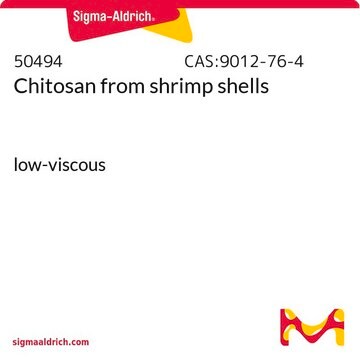Products may be shipped at a different temperature than the recommended long-term storage temperature. If the product quality is sensitive to short-term exposure to conditions other than the recommended long-term storage, it will be shipped on wet or dry-ice. If the product quality is NOT affected by short-term exposure to conditions other than the recommended long-term storage, it will be shipped at ambient temperature. As shipping routes are configured for minimum transit times, shipping at ambient temperature helps control shipping costs for our customers. For more information, please refer to the Storage and Transport Conditions document: https://www.sigmaaldrich.com/deepweb/assets/sigmaaldrich/marketing/global/documents/316/622/storage-transport-conditions-mk.pdf
C7170
Quitina from shrimp shells
practical grade, powder
Sinónimos:
Poli-(1→4)-β-N-acetil-D-glucosamina
About This Item
Productos recomendados
origen biológico
shrimp (Pandalus borealis)
Nivel de calidad
grado
practical grade
Formulario
powder
color
white to beige
temp. de almacenamiento
room temp
cadena SMILES
CC(=O)N[C@@H]1[C@H](O)O[C@@H](CO)[C@H](O)[C@H]1O
InChI
1S/C8H15NO6/c1-3(11)9-5-7(13)6(12)4(2-10)15-8(5)14/h4-8,10,12-14H,2H2,1H3,(H,9,11)/t4?,5?,6?,7?,8-/m1/s1
Clave InChI
OVRNDRQMDRJTHS-WTZNIHQSSA-N
¿Está buscando productos similares? Visita Guía de comparación de productos
Aplicación
Calidad
Otras notas
Código de clase de almacenamiento
11 - Combustible Solids
Clase de riesgo para el agua (WGK)
WGK 3
Punto de inflamabilidad (°F)
Not applicable
Punto de inflamabilidad (°C)
Not applicable
Equipo de protección personal
Eyeshields, Gloves, type N95 (US)
Elija entre una de las versiones más recientes:
Certificados de análisis (COA)
¿No ve la versión correcta?
Si necesita una versión concreta, puede buscar un certificado específico por el número de lote.
¿Ya tiene este producto?
Encuentre la documentación para los productos que ha comprado recientemente en la Biblioteca de documentos.
Los clientes también vieron
-
How is shipping temperature determined? And how is it related to the product storage temperature?
1 answer-
Helpful?
-
-
How can I determine the shelf life / expiration / retest date of this product?
1 answer-
If this product has an expiration or retest date, it will be shown on the Certificate of Analysis (COA, CofA). If there is no retest or expiration date listed on the product's COA, we do not have suitable stability data to determine a shelf life. For these products, the only date on the COA will be the release date; a retest, expiration, or use-by-date will not be displayed.
For all products, we recommend handling per defined conditions as printed in our product literature and website product descriptions. We recommend that products should be routinely inspected by customers to ensure they perform as expected.
For products without retest or expiration dates, our standard warranty of 1 year from the date of shipment is applicable.
For more information, please refer to the Product Dating Information document: https://www.sigmaaldrich.com/deepweb/assets/sigmaaldrich/marketing/global/documents/449/386/product-dating-information-mk.pdfHelpful?
-
-
Hi, May I know the density of the chitin flakes from shrimp shell?
1 answer-
The density of this product is not determined. Generally, chitin is expected to have a density of approximately 1.37 g/cm^3.
Helpful?
-
-
What is the molecular weight of chitin from shrimp shell? And the viscosity of the Chitin solution?
1 answer-
Unfortunately, the molecular weight and viscosity are not determined for this product.
Helpful?
-
-
Can you please tell me the size of the product Chitin from shrimp shells ( C7170). Can I use the Chitin for flow cytometry experiment? or do you have a smaller size of Chitin?
1 answer-
Unfortunately, the particle size of this product, as well as the alternative C9752, has not been determined. These items are not tested for a specific application, including flow cytometry. Currently, the C7170 and C9752 are the only chitin products available.
Helpful?
-
Active Filters
Nuestro equipo de científicos tiene experiencia en todas las áreas de investigación: Ciencias de la vida, Ciencia de los materiales, Síntesis química, Cromatografía, Analítica y muchas otras.
Póngase en contacto con el Servicio técnico






